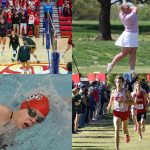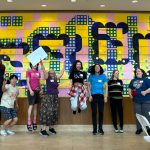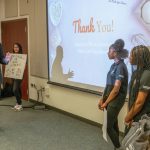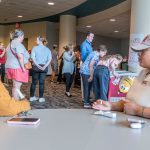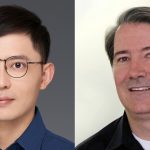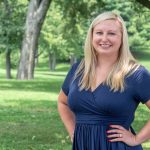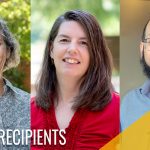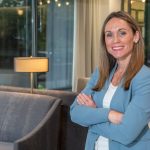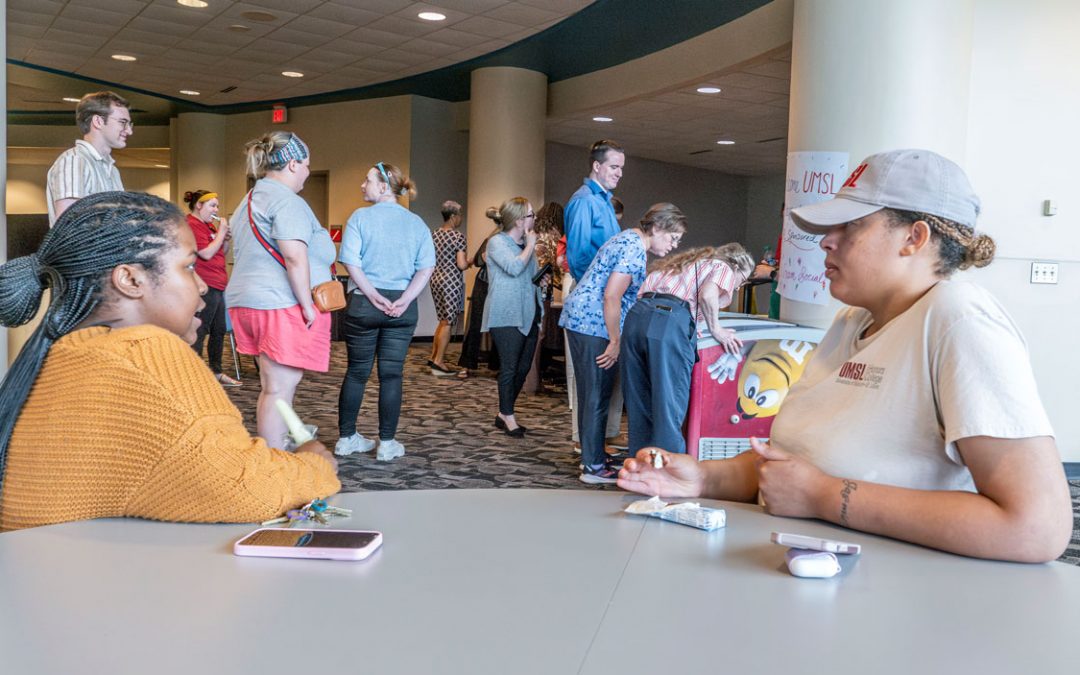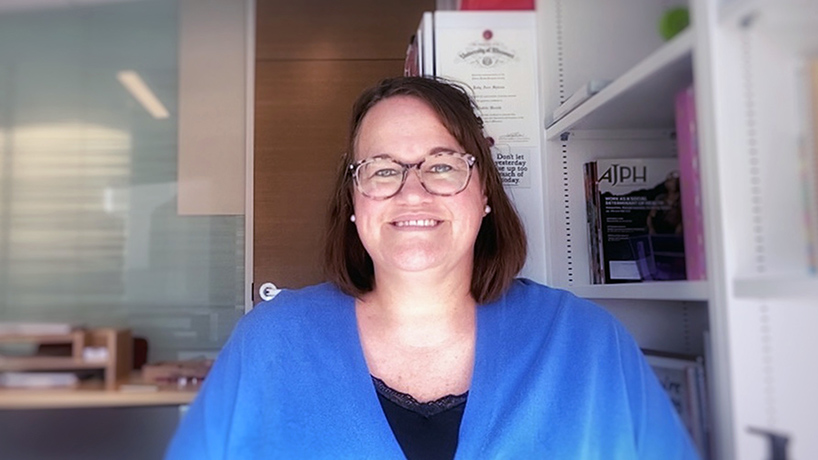
College of Nursing PhD student Jody Spiess is working on writing her dissertation on disaster preparedness in nursing education with an all-hazards approach, which encompasses situations that results in more injuries than hospitals have resources to treat. (Photo by August Jennewein)
Like it has for so much else over the last eight months, the pandemic really messed up the timeline for Jody Spiess’ dissertation research.
The University of Missouri–St. Louis nursing PhD student had sent out her questionnaire to the members of the Association of Community Health Nurse Educators right at the start of the pandemic and had received only about 60 responses – short of her goal of 100. That meant another round had to go out.
The timing of it struck Spiess because her research – which is on disaster preparedness in nurse education – encompasses pandemic preparation.
“The irony of this is so odd,” she said. “Doing research on pandemics and disasters in the middle of a disaster was crazy. The second time I sent it out, we were in really the thick of the pandemic.”
Regardless, the second survey proved fruitful, and Spiess ended up with enough data. She’s on track to wrap up both her dissertation and the program by the end of the year.
There’s something apt in having her dissertation subject matter align with the challenges outside education. That’s because, at various points in her life, Spiess’s academic and career success has been propelled by a challenge. That’s how she came to be a nurse in the first place.
At 16, Spiess became pregnant. Her family rallied around her and her daughter, Samantha, but not everyone was as supportive. Though some of the nurses were kind, others made their judgements known.
“My parents and my siblings, we all came together,” she said. “Everyone pitched in and helped, and of course, I was mom, but it was a scary time. I had her, and my parents were even in the delivery room. My sister was in the delivery room. Then, everybody went home, and I remember laying in the bed that night, and that was the night the nurse was so crabby to me. The reality of it hit me. You know, my mom and dad can’t do this for me. They’re at home. This is real.
“That experience, number one, made me realize I wanted to be a nurse and treat people with kindness and grace. But, number two, I did not want to be a statistic. I wanted to make sure that I was as successful as I possibly could be to show my daughter that we don’t quit. You don’t have to be what people think you are.”
Spiess had finished her sophomore year of high school shortly before giving birth to Samantha, and she jumped back into school that fall with no delay. After graduating, she took prerequisites then enrolled in the traditional BSN program in the UMSL College of Nursing.
Juggling the program and motherhood was a lot – too much at that time. After struggling in several classes, Spiess had no choice but to take a break.
“That was hard,” she said. “I went home, and I couldn’t decide what I should do next. Maybe nursing is not for me. But then, once again, that stubbornness and refusal to become a statistic came to the surface.”
She enrolled in nursing classes at St. Louis Community College’s Forest Park and then Meramec locations and earned her associate degree, passed the NCLEX exam to become a RN and started working at St. Anthony’s Hospital, now Mercy South.
She worked as a cardiac nurse for five years and then transferred to the postpartum unit, always taking care of the teen moms when she could. Spiess got married and had two sons with her husband. Going back to school to earn her BSN was on her mind, but it never seemed like the right time.
Then the cancer hit.
Like so many other women, Spiess received an abnormal pap test. Though that often means nothing urgent, her physician, Dr. Frank Patrick, urged her to take it seriously and do a cone biopsy. The results came back positive for cervical cancer.
At 28, she had a radical hysterectomy and, fortunately, has been in remission since.
“But that was another moment,” Spiess said. “My daughter was the first wakeup to adulthood and how important it is to do what you want and live life to the fullest. Then, the cancer was my second where I was like, “Oh, my goodness, I’m so lucky.’”
After recovery, Spiess enrolled in a BSN program at Webster University. There she found a mentor in Professor Mary Ann Drake, who introduced Spiess to public health nursing and the Nurse-Family Partnership program, which is run through the St. Louis County Department of Public Health. As soon as she graduated, Spiess went to work for the NFPP, where she visited low-income, first-time mothers from the time they found out they were pregnant to until their children were two years old.
At that job, she also discovered an interest in disasters and went through FEMA training. Over time, Spiess became a public health supervisor while continuing on at Webster to earn her MSN. She started teaching nursing first at St. Charles Community College and then at Webster, where she is now an assistant professor.
“With the FEMA training, I realized we don’t have a lot of this content in our curriculum in nursing,” she said. “I started to think about why St. Charles Community College does this amazing disaster drill every year. I had all these skills from the health department and connections with the emergency preparedness people there, and I got more and more involved.”
When Spiess decided to go for her PhD in 2016, she bonded instantly with then-Dean Roberta Lavin, who had worked for FEMA in the past, and then with Assistant Professor Umit Tokac, who became Spiess’ dissertation chair. She narrowed down her interests to disaster preparedness in public health nurse education with an all-hazards approach, which includes any event – natural or manmade – that results in more injuries than hospitals have resources to treat.
She studied historic events such as Hurricane Katrina and the Pulse nightclub shooting, searching for examples in the literature about the nursing response.
“There was some good research done asking students in nursing schools how they felt, if they feel prepared,” Spiess said. “In every article I could find, nursing students, nurses who work in hospitals and even faculty at nursing schools said they felt unprepared. That’s when I knew, ‘OK, I’ve got something here. There’s definitely a problem.’”
Spiess developed a survey that was 55 questions long and aimed to ascertain the respondent’s familiarity with pandemic preparation and how important each felt it was as a subject to teach, which she sent to the members of the ACHNE.
Though she’s still working on analyzing her results, Spiess already has some takeaways.
The nurses who had experience in prior disasters were the most familiar with the components of disaster preparedness. Almost 100 percent of the population sampled felt it was important to include disaster preparedness in their community health nursing course.
“The main piece is that the majority of the people surveyed are on the mid to lower end,” she said. “Basically, it shows that even public health nursing educators don’t feel prepared. If we don’t even feel competent, there’s no way we’re going to graduate nurses who feel competent.”
Spiess has some thoughts on how to change that by incorporating more education about disasters into the public health nurse curriculum. Living through a pandemic has made her even more certain of that than ever before.
“It’s been really weird because I’ve been interested in this for a long time,” she said. “It felt like what I was writing about was coming to life.”


